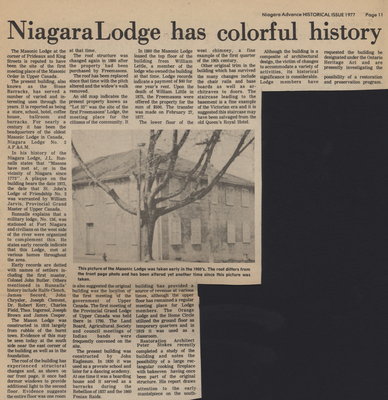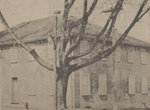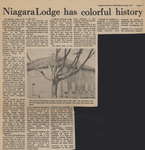Niagara Lodge has colorful history
- Publication
- Niagara Advance (Niagara-on-the-Lake, Ontario, Canada), 1977
- Full Text
NIAGARA LODGE HAS COLORFUL HISTORY
The Masonic Lodge at the corner of Prideaux and King Streets is reputed to have been the site of the first meeting place of the Masonic Order in Upper Canada.
The present building, also known as the Stone Barracks, has served a number of varied and interesting uses through the years. It is reported as being a store, school, hotel, coffee house, ballroom and barracks. For nearly a century it has been the headquarters of the oldest Masonic Lodge in Canada, Niagara Lodge No. 2 A.F.& A.M.
In his history of the Niagara Lodge, J.L. Runnalls states that "Masons have met at, or in the vicinity of Niagara since 1773". A plaque on the building bears the date 1972, the date that St. John's Lodge of Friendship No. 2 was warranted by William Jarvis, Provincial Grand Master of Upper Canada.
Runnalls explains that a military lodge, No. 156, was stationed at Fort Niagara and civilians on the west side of the river were organized to complement this. He states early records indicate that this Lodge, met at various homes throughout the area.
Early records are dotted with names of settlers including the first master, Colonel John Butler. Others mentioned in Runnalls' history include Ralfe Clench, James Secord, John Chrysler, Joseph Clement, Dr. Robert Kerr, Charles Field, Thos. Ingersol, Joseph Brown and James Cooper.
The Mason Lodge was constructed in 1816 largely from rubble of the burnt town. Evidence of this may be seen today at the south side near the east corner of the building as well as in the foundation.
The roof of the building has experienced structural changes and, as shown on our front page, it once had dormer windows to provide additional light to the second at that time. Evidence suggests the entire floor was one room at that time.
The roof structure was changed again in 1880 after the property had been purchased by Freemasons. The roof has been replaced since that time with the pitch altered and the widow's walk removed.
An old map indicates the present property known as "Lot 33" was the site of the first Freemasons' Lodge, the meeting place for the citizens of the community. It
is also suggested the original building was the location of the first meeting of the government of Upper Canada. The first meeting of the Provincial Grand Lodge of Upper Canada was held there in 1795. The Land Board, Agricultural Society and council meetings of Indian bands were frequently convened on the site.
The present building was constructed by John Eaglesum. In 1830 it was used as a private school and later for a dancing academy. At one time it was a boarding house and it served as a barracks during the Rebellion of 1837 and the 1860 Fenian Raids.
In 1860 the Masonic Lodge leased the top floor of the building from William Lettle, a member of the lodge who owned the building at that time. Lodge records indicate a payment of $40 for one year's rent. Upon the death of William Little in 1875, the Freemasons were offered the property for the sum of $500. The transfer was made on February 27, 1877.
The lower floor of the building has provided a source of revenue at various times, although the upper floor has remained a regular meeting place for Lodge members. The Orange Lodge and the Home Circle utilized the ground floor as temporary quarters and in 1919 it was used as a classroom.
Restoration Architect Peter Stokes recently
completed a study of the building and notes the possibility of a large rectangular cooking fireplace with bakeoven having once been part of the original structure. His report draws attention to the early mantelpiece on the south west chimney, a fine example of the first quarter of the 19th century.
Other original trim in the building which has survived the many changes include the chair rails and base boards as well as architraves to doors. The staircase leading to the basement is a fine example of the Victorian era and it is suggested this staircase may have been salvaged from the old Queen's Royal Hotel.
Although the building is a composite of architectural design, the victim of changes to accommodate a variety of activities, its historical significance is considerable. Lodge members have requested the building be designated under the Ontario Heritage Act and are presently investigating the possibility of a restoration and preservation program.
- Media Type
- Text
- Image
- Item Types
- Clippings
- Articles
- Description
- Article "Niagara Lodge has colorful history" published in Historical issue of Niagara Advance in 1977.
The black and white newspaper photograph of the Niagara Masonic Lodge taken in the early 1900s with caption: "This picture of the Masonic Lodge was taken early in the 1900's. The roof differs from the front page photo and has been altered yet another time since this picture was taken." To see how the lodge looked in 1977 when the paper was published, check a link "Masonic Hall in Niagara-on-the-Lake" on right side. - Date of Publication
- 1977
- Subject(s)
- Clubs
Fraternal lodges
Fraternal organizations
Historic buildings
Masonic buildings
Organizations
Organizations' facilities
Niagara-on-the-Lake, Ont
Upper Canada
Freemasonry
Masons
Men's clubs
Niagara (Ont.)--Buildings, structures, etc.
Stokes, Peter John (1929-2013)
Niagara Masonic Lodge No. 2 (Niagara-on-the-Lake) - Local identifier
- NOTLPL00244-01
- Language of Item
- English
- Geographic Coverage
-
-
Ontario, Canada
Latitude: 43.255895396406 Longitude: -79.0700992123031
-
- Copyright Statement
- Copyright status unknown. Responsibility for determining the copyright status and any use rests exclusively with the user.
- Contact
- Niagara-on-the-Lake Public LibraryEmail:localhistory@notlpl.org
Website
Agency street/mail address:10 Anderson Lane P.O. Box 430
Niagara-on-the-Lake, ON L0S 1J0
905-468-2023





